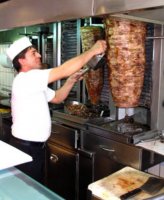...and here are a few interesting factoids about rotary engines:
- Some rotaries had just one valve (the French LeRhone Monosaupape) while others had a conventional intake and exhaust valve set-up with pushrods actuated by a cam milled into the front of the stationary crankshaft. The pushrods had rollers on the cam ends and they worked quite reliably. The cylinders were machine from steel - and so the engines were fairly heavy affairs.
- One of the key advantages of the rotary design was that even if the aircraft was flying slowly or just sitting on the ground, the cylinders were being cooled by the motion of the entire rotating assembly. Radials and in-line engines (like our XS650's) need to be flying or at least moving through the air to receive adequate cooling.
- As stated in the video - the earliest rotaries engines did not have a carburettor - they used a "mixing chamber" instead. As a result, there was only a very rudimentary throttle and so when the engine was started, it was running at, or near full power.
- None of the aircraft on which these contraptions were mounted (exclusively WW-1 airplanes) had wheel brakes nor did they have steerable tailwheels or skids - so taxiing was....exciting! Hence the need for wheel chocks. Normally, the airplanes were simply aimed straight down the runway prior to engine start so that they could take-off without trying to manoever.
- The only method that pilots had of varying the power output was to turn the ignition on and off. Some later models had a switch that could change the number of cylinders firing from 3 to 5 to all 7 (or 9 in some cases) - but this generally resulted in a large backfire out the exhaust when all 7 (or 9) were selected after a period of low power operation. In addition the backfire could occasionally set the fuselage on fire and as there were no parachutes...further excitement would ensue.
- The usual method of varying power in rotary engines was to use a "blip" switch which shut off the spark to all cylinders and that is why when WW-1 airplanes are coming in to land, you can hear the engine stopping and starting as the plane nears the ground (but once again, the backfiring issue was a concern). Pilots who flew these aircraft have told me that controlling airspeed when landing is one of the trickiest parts of operating these planes.
- The German Oberusal rotary engines (as used on the Fokker Triplane) were license-built copies of the French LeRhone (single valve) rotaries (obviously, the license was cancelled during the war in which the Germans invaded France....).
- The most powerful rotary ever built and flown was the Bentley BR2 which produced 230 HP (most of the earlier Clerget, LeRhone and Oberursels produced between 80 and 160 HP). These engines were also slow turners - most ran at between 1200 and 1500 RPM.
- The BR2 was really not a huge success and the rotary quickly died out as more powerful and reliable radials and in-line engines became available in the 1920s.
- The large rotating mass of almost the entire engine plus the propellor created a large torque which strongly affected the handling of the small light aircraft to which they were mounted. For example, the Sopwith Camel could turn MUCH more rapidly to the left than to the right - BUT - new pilots were strongly discouraged from making left hand turns because the Camel was very prone to a spin from which recovery was extremely difficult.
- There are still lots of rotary engines operating in the few original WW-1 airplanes that still fly but also in the many replicas which have been built by museums and enthusiasts around the world. One of the most widely used engine re-building shops for these engines is the Canadian National Aircraft Museum in Ottawa which has restored and operates several WW-1 aircraft.
The Museum collection also includes the only
original WW-1 German aircraft still in existence anywhere (an AEG G-IV bomber - which does not fly). It was brought to Canada as part of a collection of war prizes following the First World War. The rest of that group of airplanes was burned and buried at the Camp Borden military base northwest of Toronto in the early-mid 1930s by some philistine accountant twit.
If you are ever anywhere near Ottawa, be sure to check it out - they have amazing collection of historic aircraft!
Pete


